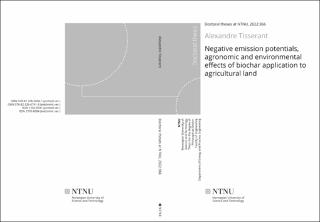| dc.contributor.advisor | Cherubini, Francesco | |
| dc.contributor.advisor | Wood, Richard | |
| dc.contributor.author | Tisserant, Alexandre Fabien Regis | |
| dc.date.accessioned | 2022-11-24T16:05:48Z | |
| dc.date.available | 2022-11-24T16:05:48Z | |
| dc.date.issued | 2022 | |
| dc.identifier.isbn | 978-82-326-6741-3 | |
| dc.identifier.issn | 2703-8084 | |
| dc.identifier.uri | https://hdl.handle.net/11250/3033946 | |
| dc.description.abstract | In 2015 the international community signed the Paris agreement with the aim of maintaining global warming below 2°C. Negative emissions technologies (NETs) that are able of removing atmospheric carbon dioxide for storage are key component of climate scenarios that reach the Paris agreement. Those technologies may be required to accompany transition to a zero emissions society, to offset diffuse and hard to decarbonized greenhouse gas emissions and potentially help bring back down the temperature if the climate target is overshot. Several NETs have been proposed, some concerns exist regarding their efficacy, the amount of material, energy or land they may require and how they may negatively impact other sustainable goals, such as biodiversity and food production. Investing the climate mitigation potential of these technologies requires to account for emissions happening along their supply chains and quantifying co-benefits and/or trade-offs against other sustainable or environmental targets. This thesis takes this perspective to investigate a specific NET: biochar. Biochar emerged in the recent years as a win–win option that can act both as a carbon sink and as amendment improving soil quality, increase fertility, and water holding capacity.
The first part of the work was to develop a framework for analysis of biochar systems by reviewing literature on biochar, its global warming mitigation potential and how it may affect climate both locally and globally, its soil effects, the potential use of its co-products (e.g. syngas and bio-oil) and previous work regarding its environmental assessment (Chapter 1). Biochar can supply substantial negative emissions at the global level, while its co-products can be used for energy production offsetting fossil emissions, while condensing bio-oil and storing it in geological deposits could provide additional carbon sequestration. Biochar can improve agronomic performance and reduce some soil emissions, but also increase others. Those effects vary depending on its production condition, soil conditions and background climate, and field management of biochar. Biochar can also affect local climate by changing land surface energy balance and the emissions of some short-lived gases that have a climate effect.
The rest of the work was to quantify negative emission potentials and associated co-benefits and trade-offs of large-scale deployment of biochar in Norway, using forest residues (Chapter 2) and in Europe, using both crop and forest residues (Chapter 3). Three system are investigated biochar, biochar and energy production in a combined heat and power cycle (CHP), and sequestration of both biochar and bio-oil. Biochar can offset about 1.3% (17.4%) of Norwegian (agricultural) GHG emissions per year, and between 1.6% and 3.7% (14.2% and 31.7%) of European (agricultural) emissions per year depending on feedstock supply availability. Sequestration of the bio-oil can almost double those potentials. Additional climate mitigation from the CHP are larger in Europe due to more carbon-intensive energy mix compared to Norway. Biochar can increase crop yield, soil water retention over large areas in Europe, and reduce agricultural impacts in some environmental categories, but increase in others. However, when taking the life-cycle perspective biochar systems are typically net positive impacts generator due to emissions happening in the supply-chain.
The sooner net zero emissions can be achieved, the less reliant on deploying NETs we will be to reach the Paris agreement. Biochar production is a well-known process, is cost effective and can ramp up negative emissions while improving soil health before other NET deployment maturity. | en_US |
| dc.language.iso | eng | en_US |
| dc.publisher | NTNU | en_US |
| dc.relation.ispartofseries | Doctoral theses at NTNU;2022:366 | |
| dc.relation.haspart | Paper 1: Tisserant, Alexandre; Cherubini, Francesco. Potentials, limitations, co-benefits, and trade-offs of biochar applications to soils for climate change mitigation. Land 2019 ;Volum 8:179.(12) s. 1-34 | en_US |
| dc.relation.haspart | Paper 2: Tisserant, Alexandre; Morales, Marjorie; Cavalett, Otávio; O'Toole, Adam; Weldon, Simon Mark; Rasse, Daniel; Cherubini, Francesco. Life-cycle assessment to unravel co-benefits and trade-offs of large-scale biochar deployment in Norwegian agriculture. Resources, Conservation and Recycling 2021 ;Volum 179. s. - | en_US |
| dc.relation.haspart | Paper 3: Alexandre Tisserant, Xiangping Hu, Qi Liu, Zubin Xie, Wenwu Zhao and Francesco Cherubini. Biochar and its potential to deliver negative emissions and better soil quality in Europe. This paper is submitted for publication and is therefore not included. | en_US |
| dc.title | Negative emission potentials, agronomic and environmental effects of biochar application to agricultural land | en_US |
| dc.type | Doctoral thesis | en_US |
| dc.subject.nsi | VDP::Teknologi: 500 | en_US |

